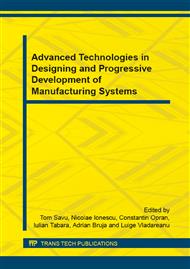p.21
p.27
p.33
p.39
p.45
p.51
p.57
p.63
p.69
Tolerance Allocation Using Design of Experiments
Abstract:
Tolerance design plays a very important in any manufacturing process because this activity directly influences products cost and quality. In design activity the designer solve the quality problems selecting tight tolerances for components but this generates cost increasing. The practical problem is to assure the high quality characteristics using the maximum tolerances for components that influence them. The paper’s aim is to find optimal parameters setting which assure the desire value of quality characteristics using the DoE (Design of Experiments), and to find a mathematical model and a respective quality characteristic function of the parameters that it was influenced. Using the mathematical function, by imposing the desired tolerance for quality characteristic, it will be allocated the optimal tolerance for components. This tolerance allocation will be verified using Monte-Carlo method.
Info:
Periodical:
Pages:
45-50
Citation:
Online since:
May 2015
Authors:
Price:
Сopyright:
© 2015 Trans Tech Publications Ltd. All Rights Reserved
Share:
Citation:


